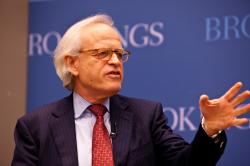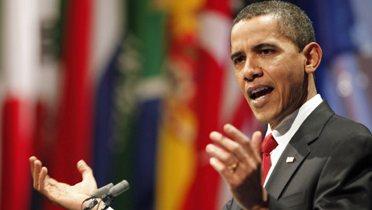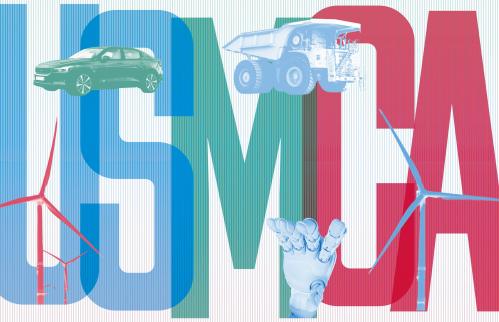Index #3: Previous Four Years
Judged by most standards, America and the world are better off today than they were a year ago when President Obama entered office. While few Americans will forget the fear of global economic meltdown that accompanied the 44th president’s inauguration and the drastic stimulus and triage measures that had to be taken to arrest the economic freefall, public optimism, as measured by a variety of opinion poll measures, has recovered.
But many workers, especially those in the once-thriving Sun Belt, are still suffering severe unemployment. In some ways, we’ve faced a marked decline since 2006, when world GDP growth was at nearly 4 percent and world trade growth was more than 20 percentage points higher than in 2009. In this third “How We’re Doing” Index, a team of Brookings experts takes a four-year look at key local, domestic and global indicators to gauge the shifting position of the United States and the larger international system.
Continue reading below chart »
“Common Defense”
|
2006 |
2007 |
2008 |
2009 |
|
| Global fatalities from terrorism (monthly average) | 1700 | 1900 | 1300 | 1300 (thru Sept.) |
| Number of U.S. troops in Iraq and Afghanistan at year’s end (1,000s) | 162 | 185 | 177 | 178 |
| U.S. military combat fatalities in Iraq and Afghanistan | 918 | 990 | 468 | 449 |
| U.S. popularity abroad, by region: | ||||
| Asia | 52 | 51 | 55 | 61 |
| Europe | 39 | 46 | 45 | 67 |
| Middle East/Islamic World | 23 | 27 | 27 | 31 |
“General Welfare”
|
2006 |
2007 |
2008 |
2009 |
|
| U.S. real GDP growth (annual percent change) | 2.7% | 2.1% | 0.4% | -2.4% |
| World GDP growth (annual percent change) | 3.9% | 3.8% | 1.8% | -2.1% |
| Brazil GDP growth | 4.0% | 5.7% | 5.1% | -0.7% |
| China GDP growth | 11.6% | 13.0% | 9.0% | 8.5% |
| India GDP growth | 9.8% | 9.4% | 7.3% | 5.4% |
| South Africa GDP growth | 5.3% | 5.1% | 3.1% | -2.2% |
| World trade growth (annual percent change) | 9.1 | 7.3 | 2.8 | -12.3 |
| Workers’ remittances (world inflows, annual percent change) | 15.3% | 21.3% | 15.3% | -5.3% |
| U.S. federal debt as percent of GDP | 36.5% | 36.2% | 40.2% | 53.0% |
| U.S. unemployment rate (avg. among persons 16 years and older) | 4.6% | 4.6% | 5.8% | 9.3% |
| Inflation rate (CPI-U, all urban consumers) | 2.5% | 4.1% | 0.1% | 2.7% |
| Percent change in U.S. payroll employment (December from one year prior) | 1.6% | 0.8% | -2.6% | -3.6% |
| Percent change in payroll employment in the Washington, DC metro area (December from one year prior) | 1.3% | 0.7% | -0.5% | -0.5% |
| Percent change in payroll employment in the Las Vegas metro area (December from one year prior) | 2.7% | 0.9% | -3.9% | -7.4% |
| Percent change in payroll employment in the Cleveland metro area (December from one year prior) | -0.4% | -0.4% | -3.3% | -4.1% |
| Dow Jones Industrial Average at year’s end | 12,463 | 13,265 | 8,776 | 10,428 |
| 30-year conventional mortgage rate at year’s end | 6.14% | 6.10% | 5.29% | 4.93% |
| Personal saving rate | 2.4% | 1.7% | 2.7% | 4.3% |
| Consumer sentiment index at year’s end (1966 = 100) | 91.7 | 75.5 | 60.1 | 72.5 |
“Blessings of Liberty”
|
2006 |
2007 |
2008 |
2009 |
|
| Avg. global happiness (0-10 scale) | 5.41 | 5.51 | 5.41 | 5.45 |
| Avg. approval rating of the president | 38% | 34% | 30% | 57% |
| Avg. approval rating of Congress | 25% | 27% | 19% | 30% |
| Avg. satisfied rating by Americans | 31% | 28% | 15% | 27% |
| Gap between Republican and Democratic presidential approval ratings | 71% | 66% | 61% | 65% |
For all of President Obama’s domestic headaches, U.S. popularity abroad is up, especially in Europe, where approval of America has nearly doubled since 2006. Presidential popularity at home, at 57 percent, is also significantly higher than it was during the previous four years. Even average happiness levels – which fell markedly with the crisis in 2008 – increased in most regions of the world (except Europe) in 2009.
America’s positive image abroad should facilitate greater cooperation as the world’s leaders find it easier to work with a United States that is more popular with their people. However, it is notable that the rebound in popularity in Europe and Asia is twice that of the Arab and Muslim World, and this despite President Obama’s determined and deft outreach to this latter constituency in particular. They like the new tone emanating from Washington but their skepticism remains because of the lack of results so far on the symbolic issues where Obama promised the most significant changes: Israeli-Palestinian peace; the closing of Guantanamo; and engagement with Iran.
Although virtually all key indicators in the global economy fell significantly last year, people can breathe easier today. Economic projections for 2010 are much more positive, although there is plenty of debate about how strong and sustainable the recovery will be, particularly in the advanced economies of the United States, Europe and Japan, where slow jobs growth and high debt levels increasingly constrain governments’ abilities to stimulate economic growth without generating inflation.
Ironically, these economies are now dependent on the continued successful performance of the developing and emerging market economies, which have outperformed the more advanced economies in weathering the crisis and now in projected performance. These economies maintained positive GDP growth rates (on average) for 2009 and are projected to grow 6 percent in 2010, in comparison with negative 2009 growth and insipid 2.1 percent 2010 growth for the advanced economies.
There is a second, greater irony embedded in these growth statistics: the advanced economies that drove the financial crisis – with the United States front and center – were poster children for poor fiscal management, over-leveraged debt, and inadequate financial regulations. The looming debt crisis in Greece is case in point. In contrast, the emerging market economies were able to weather the storm and recover more quickly primarily because, for the most part, they followed the “Washington consensus” reforms recommended by American-influenced international financial institutions – fiscal and regulatory discipline, liberalized and diversified trade regimes, and reduced foreign debt obligations.
These emerging economies are not free of economic challenges, but they have emerged from the crisis as a force to be reckoned with. And they know it. The newfound confidence of China, India and Brazil in particular has bred an expectation that their emerging power status will be recognized and accommodated within the international system. This has already begun to generate tensions, most noticeably in the increasingly scratchy relationship between China and the United States.
Managing the adjustment of these shifting balances of power will need President Obama’s sustained attention. In this regard, he has been helped by the resetting of relations with Russia, which should result in a new arms reduction treaty and greater international cooperation in dealing with the threats of nuclear proliferation from Iran and North Korea.
The successful management of U.S. troop withdrawals from Iraq is evidenced by the fact that civilian fatalities have dropped by half in the past four years and the contest for power is shifting to the political arena as new elections loom. Setbacks will be inevitable but if the positive momentum can be maintained through 2010 on the military and political levels, the focus can then shift to the important task of integrating a recovering Iraq into a regional Gulf security framework.
That will also enable the United States to focus attention on Iran, the other Gulf power, which seems increasingly determined to reach the nuclear weapons threshold in 2010. The domestic upheaval in 2009 caused by the stealing of the June elections has generated a split within the Iranian regime, and between the regime and the people, with unpredictable results. For the time being the hardliners seem to have consolidated their control and recently discovered that defiance of international demands to curb their nuclear program can help shift the public focus to outside challenges.
This Iranian defiance comes at a time when President Obama is under political pressure to demonstrate that he is strong on national security issues. He also must protect his signature foreign policy initiative of strengthening the nuclear non-proliferation regime. He seems to have chosen Iran’s nuclear program as the place where he will plant his flag and take a stand to prevent a nuclear arms race in the Middle East. Growing tensions and possible confrontation loom on the horizon.
Again, it is ironic that while Obama is perceived as weak and unable to deliver internationally, on the terrorism issue – the most critical national security concern for the American people – 2009 saw important progress. Casualties from terrorist attacks held steady while the number of leading Al Qaeda and Taliban militants that were killed or captured increased dramatically from the Pakistan military. Whether Obama’s decision to send 30,000 additional troops to Afghanistan, combined with a new political strategy of splitting the Taliban troops from their leadership and their leadership from Al Qaeda, will succeed in 2010 is far from clear. The question that hangs over the whole enterprise is whether the Afghan government, army, and police, will be capable of reasserting control of the territory and people won back from the Taliban by the more sophisticated application of NATO force.
That question is particularly important because President Obama has made clear that withdrawal of American troops from Afghanistan will begin in 18 months. Although this commitment is conditioned on prevailing circumstances at the time, it underscores a new reality with which the United States must start to come to terms in 2010. The massive debt overhang – already 53 percent of GDP, or a massive $7.5 trillion this year, is on a path to grow to an even larger $8.8 trillion or 60% of GDP in 2010. Resolving this will require a serious belt-tightening exercise. So far the Obama administration has fenced off expenditures on national security. But this is simply unsustainable over time. Cuts in the defense budget will be as necessary as reductions in other non-discretionary spending by the U.S. Government. And that will inevitably mean reduced commitments abroad.
In short, while the world is clearly – and more happily – recovering from the crises of 2009, new crises and challenges loom on the horizon for the United States. In national security as in economics, we are not out of the woods yet.
See also:
» GovWatch—tracking the progress and performance of our institutions in economic recovery
» MetroMonitor—a barometer of the health of America’s 100 largest metropolitan economies
Sources:
Congressional Budget Office. The Budget and Economic Outlook: FY 2010 to 2020. Table F-1 and F-2. http://www.cbo.gov/ftpdocs/108xx/doc10871/01-26-Outlook.pdf
Global Life Satisfaction Calculations, by Graham and Chattopadhyay (2010), Brookings Institution, based on Gallup World Polls (2006-2009)
Global Fatalities from Terrorism: Worldwide Incidents Tracking System (WITS) http://wits.nctc.gov/Main.do
The Gallup Organization. “Presidential Approval.” Gallup Poll News Service; unpublished data from the Gallup Poll (http://www.gallup.com)
The Gallup Organization. “Presidential Approval Ratings – Barack Obama.” Retrieved January 20, 2010 from The Gallup Poll web site. http://www.gallup.com/poll/116479/Barack-Obama-Presidential-Job-Approval.aspx
The Gallup Organization. “Congress and the Public.” Retrieved January 20, 2010, from The Gallup Poll. http://www.gallup.com/poll/1600/Congress-Public.aspx
IMF World Economic Outlook (WEO), October 2009 for 2005-2007, WEO January 2010 update for 2008-2011. NOTE: 2009 figures are IMF estimates. Country level GDP in constant prices
Remittances: International Financial Statisitcs service of the International Monetary Fund , http://www.imfstatistics.org/imf/
U.S. Bureau of Economic Analysis, NIPA Table 1.1.1 (January 2010)
U.S. Bureau of Labor Statistics, Consumer Price Index, All Urban Consumers, Seasonally Adjusted (Janaury 2010) http://www.bls.gov/CPI
U.S. Bureau of Labor Statistics, Current Population Survey Unemployment Data (January 2010) http://www.bls.gov/cps/
U.S. Bureau of Labor Statistics Current Employment Statistics (February 2010) http://www.bls.gov/ces/
Reuters/University of Michigan. Archived at Federal Reserve Bank of St. Louis Economic Database (FRED) (February 2010) http://research.stlouisfed.org/fred2/
Freddie Mac Primary Mortgage Market Survey
U.S. War Fatalities: Department of Defense http://siadapp.dmdc.osd.mil/personnel/CASUALTY/castop.htm
U.S. Popularity Abroad: The Pew Global Attitudes Surveys (2006-2009) http://pewglobal.org/database/?indicator=1
The Brookings Institution is committed to quality, independence, and impact.
We are supported by a diverse array of funders. In line with our values and policies, each Brookings publication represents the sole views of its author(s).





